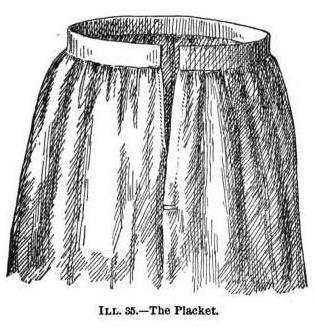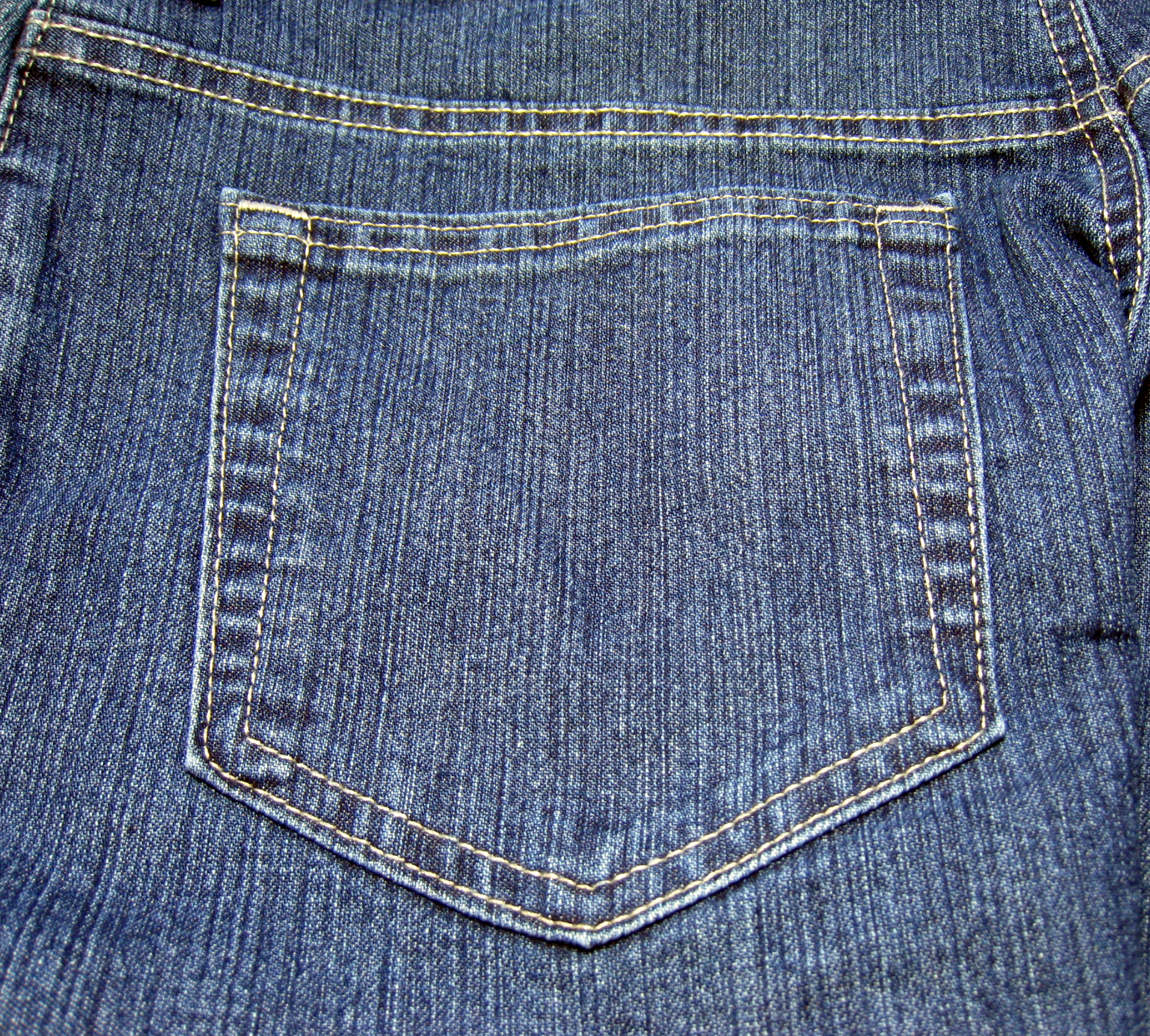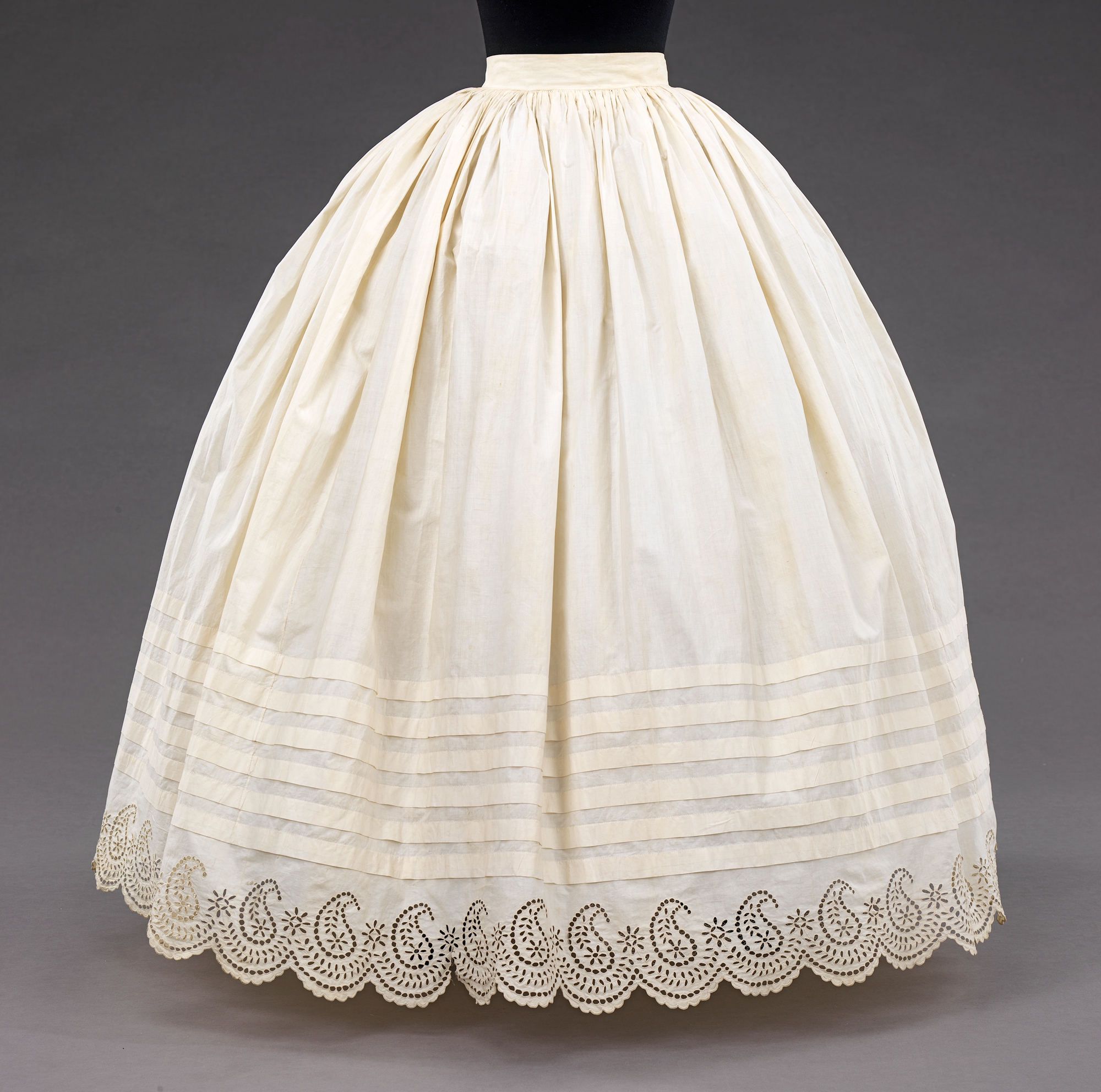|
Placket
A placket (also spelled placquet) is an opening in the upper part of trousers or skirts, or at the neck or sleeve of a garment. Plackets are almost always used to allow clothing to be put on or removed easily but are sometimes used purely as a design element. Modern plackets often contain fabric facings or attached bands to surround and reinforce fasteners such as buttons, snaps, or zippers. Construction In modern usage, the term ''placket'' often refers to the double layers of fabric that hold the buttons and buttonholes in a shirt. Plackets can also be found at the neckline of a shirt, the cuff of a sleeve, or at the waist of a skirt or pair of trousers. Plackets are almost always made of more than one layer of fabric, and often have interfacing in between the fabric layers. This is done to give support and strength to the placket fabric because the placket and the fasteners on it are often subjected to stress when the garment is worn. The two sides of the placket often overl ... [...More Info...] [...Related Items...] OR: [Wikipedia] [Google] [Baidu] |
Shirt
A shirt is a cloth garment for the upper body (from the neck to the waist). Originally an undergarment worn exclusively by men, it has become, in American English, a catch-all term for a broad variety of upper-body garments and undergarments. In British English, a shirt is more specifically a garment with a collar, sleeves with cuffs, and a full vertical opening with buttons or snaps (North Americans would call that a "dress shirt", a specific type of collared shirt). A shirt can also be worn with a necktie under the shirt collar. History The world's oldest preserved garment, discovered by Flinders Petrie, is a "highly sophisticated" linen shirt from a First Dynasty Egyptian tomb at Tarkan, dated to c. 3000 BC: "the shoulders and sleeves have been finely pleated to give form-fitting trimness while allowing the wearer room to move. The small fringe formed during weaving along one edge of the cloth has been placed by the designer to decorate the neck opening and side seam." Th ... [...More Info...] [...Related Items...] OR: [Wikipedia] [Google] [Baidu] |
Stomacher
A stomacher is a decorated triangular panel that fills in the front opening of a woman's gown or bodice. The stomacher may be boned, as part of a corset, or may cover the triangular front of a corset. If simply decorative, the stomacher lies over the triangular front panel of the stays, being either stitched or pinned into place, or held in place by the lacings of the gown's bodice. A stomacher may also be a piece or set of jewellery to ornament a stomacher or bodice. Early stomachers In the 15th and 16th centuries, men and women both wore decorative stomachers (often called placards or plackets) with open-fronted doublets and gowns. The form and style of these stomachers in combination with the headgear is often used to date paintings to a certain time period. In 1603, Elizabeth Wriothesley, Countess of Southampton, who was pregnant, wrote to her husband in London asking him to buy her a stomacher, 'buy me a "stumiger" of scarlet, half a yard broad, and as long at least, li ... [...More Info...] [...Related Items...] OR: [Wikipedia] [Google] [Baidu] |
Illustration Of A Placket
An illustration is a decoration, interpretation or visual explanation of a text, concept or process, designed for integration in print and digital published media, such as posters, flyers, magazines, books, teaching materials, animations, video games and films. An illustration is typically created by an illustrator. Digital illustrations are often used to make websites and apps more user-friendly, such as the use of emojis to accompany digital type. llustration also means providing an example; either in writing or in picture form. The origin of the word "illustration" is late Middle English (in the sense ‘illumination; spiritual or intellectual enlightenment’): via Old French from Latin ''illustratio''(n-), from the verb ''illustrare''. Illustration styles Contemporary illustration uses a wide range of styles and techniques, including drawing, painting, printmaking, collage, montage, digital design, multimedia, 3D modelling. Depending on the purpose, illustration ma ... [...More Info...] [...Related Items...] OR: [Wikipedia] [Google] [Baidu] |
Pocket
A pocket is a bag- or envelope-like receptacle either fastened to or inserted in an article of clothing to hold small items. Pockets are also attached to luggage, backpacks, and similar items. In older usage, a pocket was a separate small bag or pouch. Origins Ancient people used leather or cloth pouches to hold valuables. Ötzi (also called the "Iceman"), who lived around 3,300 BCE, had a belt with a pouch sewn to it that contained a cache of useful items: a scraper, drill, flint flake, bone awl, and a dried tinder fungus. In European clothing, fitchets, resembling modern day pockets, appeared in the 13th century. Vertical slits were cut in the super tunic, which did not have any side openings, to allow access to purse or keys slung from the girdle of the tunic. According to historian Rebecca Unsworth, it was in the late 15th century that pockets became more noticeable. During the 16th century, pockets increased in popularity and prevalence. In slightly later European cloth ... [...More Info...] [...Related Items...] OR: [Wikipedia] [Google] [Baidu] |
Petticoat
A petticoat or underskirt is an article of clothing, a type of undergarment worn under a skirt or a dress. Its precise meaning varies over centuries and between countries. According to the ''Oxford English Dictionary'', in current British English, a petticoat is "a light loose undergarment ... hanging from the shoulders or waist". In modern American usage, "petticoat" refers only to a garment hanging from the waist. They are most often made of cotton, silk or tulle. Without petticoats, skirts of the 1850s would not have the volume they were known for. In historical contexts (16th to mid-19th centuries), ''petticoat'' refers to any separate skirt worn with a gown, bedgown, bodice or jacket; these petticoats are not, strictly speaking, underwear, as they were made to be seen. In both historical and modern contexts, ''petticoat'' refers to skirt-like undergarments worn for warmth or to give the skirt or dress the desired attractive shape. Terminology Sometimes a petticoat may be ... [...More Info...] [...Related Items...] OR: [Wikipedia] [Google] [Baidu] |
1500–1550 In Fashion
Fifteen or 15 may refer to: *15 (number), the natural number following 14 and preceding 16 *one of the years 15 BC, AD 15, 1915, 2015 Music *Fifteen (band), a punk rock band Albums * ''15'' (Buckcherry album), 2005 * ''15'' (Ani Lorak album), 2007 * ''15'' (Phatfish album), 2008 * ''15'' (mixtape), a 2018 mixtape by Bhad Bhabie * ''Fifteen'' (Green River Ordinance album), 2016 * ''Fifteen'' (The Wailin' Jennys album), 2017 * ''Fifteen'', a 2012 album by Colin James Songs * "Fifteen" (song), a 2008 song by Taylor Swift *"Fifteen", a song by Harry Belafonte from the album '' Love Is a Gentle Thing'' *"15", a song by Rilo Kiley from the album ''Under the Blacklight'' *"15", a song by Marilyn Manson from the album ''The High End of Low'' *"The 15th", a 1979 song by Wire Other uses *Fifteen, Ohio, a community in the United States * ''15'' (film), a 2003 Singaporean film * ''Fifteen'' (TV series), international release name of ''Hillside'', a Canadian-American teen drama *Fi ... [...More Info...] [...Related Items...] OR: [Wikipedia] [Google] [Baidu] |
Gown
A gown, from the Saxon word, ''gunna'', is a usually loose outer garment from knee-to-full-length worn by men and women in Europe from the Early Middle Ages to the 17th century, and continuing today in certain professions; later, the term ''gown'' was applied to any full-length woman's garment consisting of a bodice and an attached skirt. A long, loosely fitted gown called a Banyan was worn by men in the 18th century as an informal coat. The gowns worn today by academics, judges, and some clergy derive directly from the everyday garments worn by their medieval predecessors, formalized into a uniform in the course of the 16th and 17th centuries. Terminology A modern-day gown refers to several types of garments. It can refer to a woman's dress, especially a formal or fancy dress. It may also refer to a nightgown or a dressing gown. In academia, and other traditional areas such as the legal world, gowns are also worn on various formal or ceremonial occasions. History The ''g ... [...More Info...] [...Related Items...] OR: [Wikipedia] [Google] [Baidu] |
Doublet (clothing)
A doublet (/ˈdʌblɪt/; derived from the Ital. ''giubbetta'') is a man's snug-fitting jacket that is shaped and fitted to the man's body. The garment was worn in Spain, and spread to the rest of Western Europe, from the late Middle Ages up to the mid-17th century. The doublet was hip length or waist length and worn over the shirt or drawers. Until the end of the 15th century, the doublet was usually worn under another layer of clothing such as a gown, mantle, overtunic or jerkin when in public. Originally it was a mere stitched and quilted lining ("doubling"), worn under a hauberk or cuirass to prevent bruising and chafing. Doublets were sometimes opened to the waistline in a deep V. The edges might be left free or laced across the shirt front. If there was space left it might be filled with a stomacher. By the 1520s, the edges of the doublet more frequently met at the center front. Then, like many other originally practical items in the history of men's wear, from the late 15 ... [...More Info...] [...Related Items...] OR: [Wikipedia] [Google] [Baidu] |
Interfacing
Interfacing is a textile used on the unseen or "wrong" side of fabrics to make an area of a garment more rigid. Interfacings can be used to: *stiffen or add body to fabric, such as the interfacing used in shirt collars *strengthen a certain area of the fabric, for instance where buttonholes will be sewn *keep fabrics from stretching out of shape, particularly knit fabrics Interfacings come in a variety of weights and stiffnesses to suit different purposes. They are also available in different colours, although typically interfacing is white. Generally, the heavier weight a fabric is, the heavier weight an interfacing it will use. Interfacing is sold at fabric stores by the yard or metre from bolts, similar to cutting fabric. Sewing patterns specify if interfacing is needed, the weight of interfacing that is required, and the amount. Some patterns use the same fabric as the garment to create an interfacing, as with sheer fabrics. Interfacing has three main 'types': woven, no ... [...More Info...] [...Related Items...] OR: [Wikipedia] [Google] [Baidu] |
Cuff
A cuff is a layer of fabric at the lower edge of the sleeve of a garment (shirt, coat, jacket, etc.) at the wrist, or at the ankle end of a trouser leg. The function of turned-back cuffs is to protect the cloth of the garment from fraying, and, when frayed, to allow the cuffs to be readily repaired or replaced, without changing the garment. Cuffs are made by turning back (folding) the material, or a separate band of material can be sewn on, or worn separately, attached either by buttons or studs. A cuff may display an ornamental border or have lace or some other trimming. In US usage, the word ''trouser cuffs'' refers to the folded, finished bottoms of the legs of a pair of trousers. In the UK, while this usage is now sometimes followed, the traditional term for the turned up trouser hem is 'turnup'. History Between the 15th and 18th centuries, rich men often wore sleeve cuffs ornamented with fine lace. Still today, Catholic clergy have the cuffs of their choir dress ornamen ... [...More Info...] [...Related Items...] OR: [Wikipedia] [Google] [Baidu] |
Fabric
Textile is an umbrella term that includes various fiber-based materials, including fibers, yarns, filaments, threads, different fabric types, etc. At first, the word "textiles" only referred to woven fabrics. However, weaving is not the only manufacturing method, and many other methods were later developed to form textile structures based on their intended use. Knitting and non-woven are other popular types of fabric manufacturing. In the contemporary world, textiles satisfy the material needs for versatile applications, from simple daily clothing to bulletproof jackets, spacesuits, and doctor's gowns. Textiles are divided into two groups: Domestic purposes onsumer textilesand technical textiles. In consumer textiles, aesthetics and comfort are the most important factors, but in technical textiles, functional properties are the priority. Geotextiles, industrial textiles, medical textiles, and many other areas are examples of technical textiles, whereas clothing and ... [...More Info...] [...Related Items...] OR: [Wikipedia] [Google] [Baidu] |
Front Placket Of Shirt
Front may refer to: Arts, entertainment, and media Films * ''The Front'' (1943 film), a 1943 Soviet drama film * ''The Front'', 1976 film Music *The Front (band), an American rock band signed to Columbia Records and active in the 1980s and early 1990s *The Front (Canadian band), a Canadian studio band from the 1980s Periodicals * ''Front'' (magazine), a British men's magazine * '' Front Illustrated Paper'', a publication of the Yugoslav People's Army Television * Front TV, a Toronto broadcast design and branding firm * "The Front" (''The Blacklist''), a 2014 episode of the TV series ''The Blacklist'' * "The Front" (''The Simpsons''), a 1993 episode of the TV series ''The Simpsons'' Military * Front (military), a geographical area where armies are engaged in conflict * Front (military formation), roughly, an army group, especially in eastern Europe Places * Front, California, former name of Brown, California * Front, Piedmont, an Italian municipality * The Front, now par ... [...More Info...] [...Related Items...] OR: [Wikipedia] [Google] [Baidu] |








